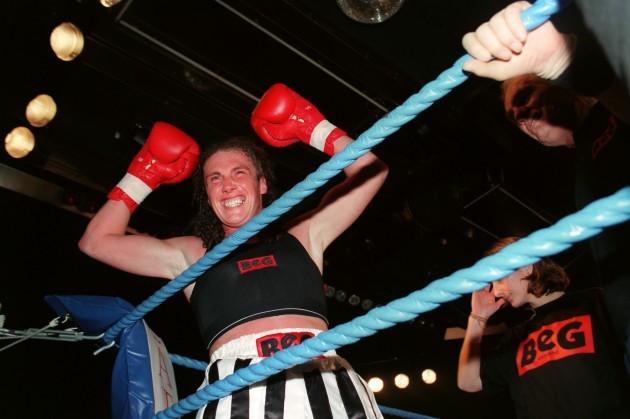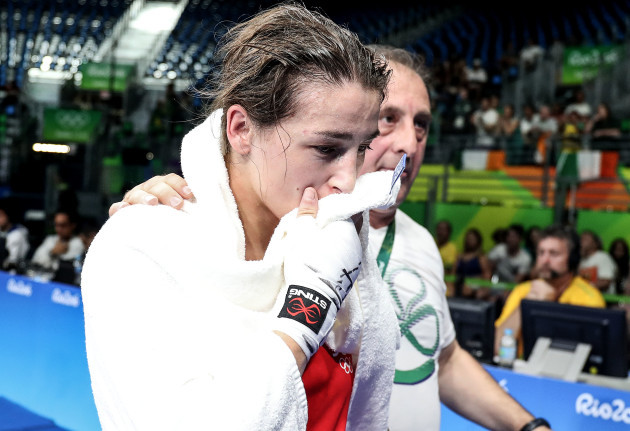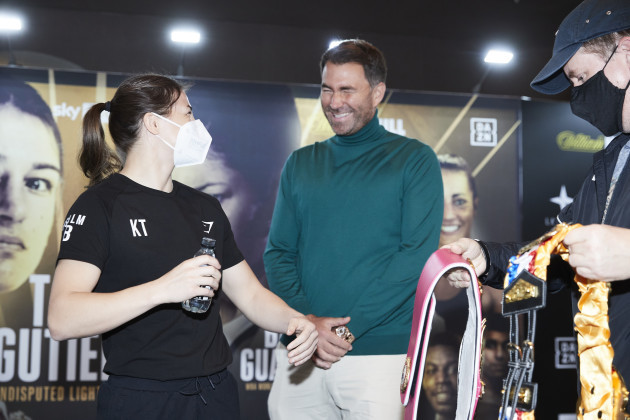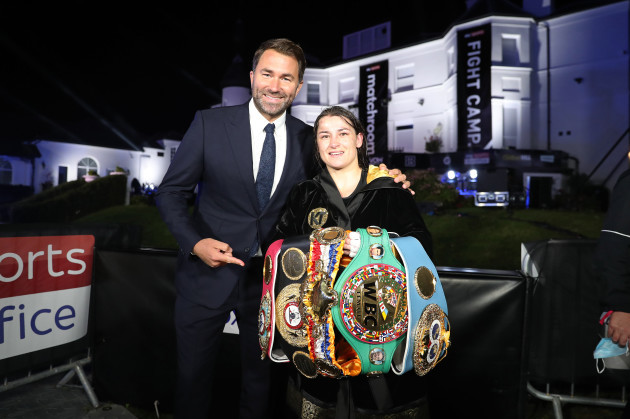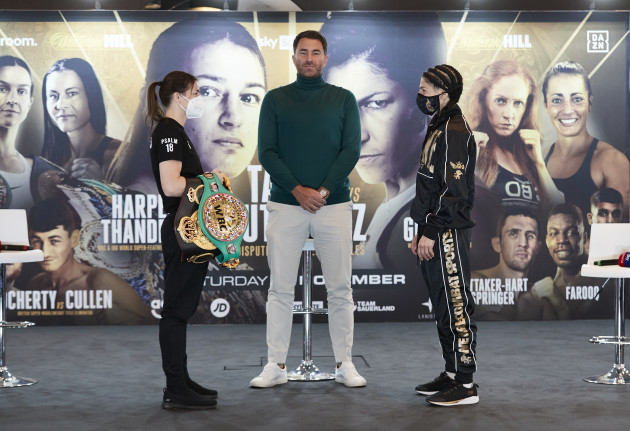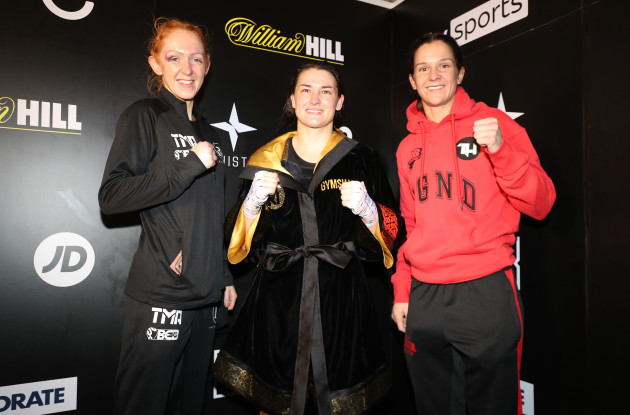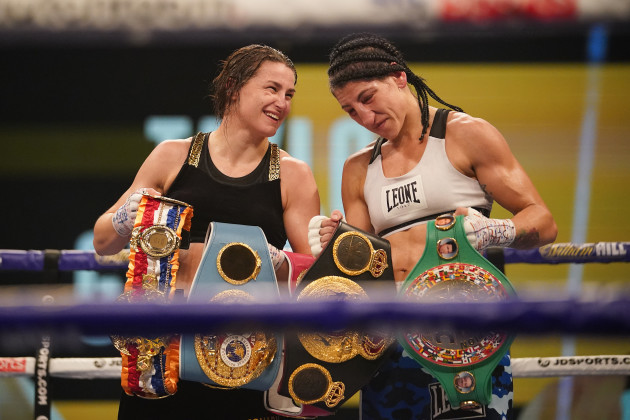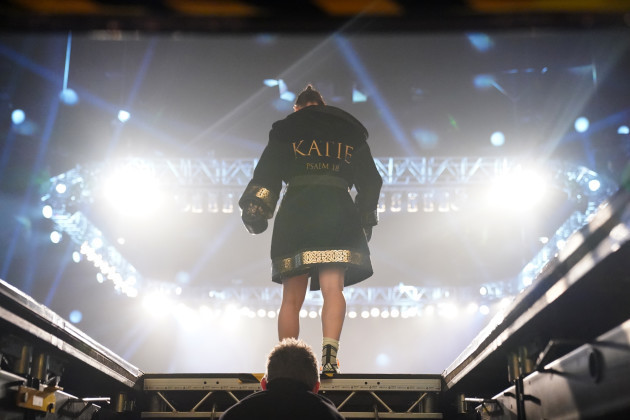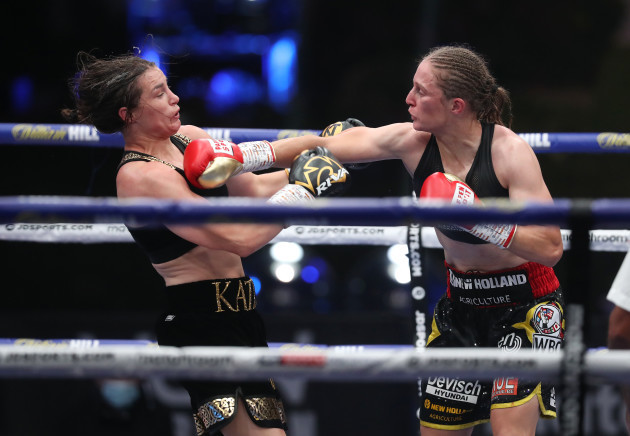WITH THE NUMBER of people allowed into British arenas for professional boxing events restricted to a bare minimum during the pandemic, Sky Sports have, like the rest of us, leaned heavily on Zoom. Instead of sitting a fighter’s archnemesis ringside to run the rule over their performance ahead of a prospective future showdown, Sky have concocted the concept of Goggleboxers, wherein the televised broadcast frequently cuts away to an interested party studying the action from their couch.
They applied a poetic twist to that particular quirk during Saturday’s novel female world-title tripleheader, however. During natural lulls between rounds, viewers were treated to the sight of professional boxing’s most important Couch of all — retired former world champion Jane Couch — who sat on hers, watching the fruits of her life’s labour unfold on primetime television.
It was fitting that on a night during which one of female boxing’s most adored pioneers, Katie Taylor, topped a Sky-broadcast bill for the first time on a Saturday night, she shared some screentime with the woman who technically made it possible. Equally fitting was the fact that Taylor and her supporting cast of Terri Harper and Rachel Ball put their fists through the glass ceiling at Wembley Arena, of all places.
In 1997, Couch was forced to turn down a £10,000 opportunity to fight at the same indoor venue when the British Boxing Board of Control (BBBofC) refused her a professional boxing licence on account of her being a woman. She was, at the time, a world champion with a 5-0 record. A year later, she took the British board to court. The board’s solicitor, Bernard Buckley, argued during the landmark discrimination case that “many women suffer from premenstrual tension which makes them more emotional and more labile and accident-prone. They are too fragile to box and they bruise easily.”
Couch won the case, as a result of which the BBBofC were mandated to grant licences to qualifying female applicants and, by extension, allow them to compete for the first time in sanctioned professional bouts on UK soil. Couch received £15,000 in compensation, but the court victory did her little good aside from afford her the relative luxury of fighting in her home country: she continued to be ridiculed by the tabloids and within male-dominated boxing circles.
In a moving interview with Donald McRae in The Guardian last year, she repeatedly described herself as “damaged” — not by her 39 experiences in the ring but by the incalculably cruel treatment she received outside of it.
These days, she contends that the public simply wasn’t “ready” to embrace her and her pugilistic peers in the ’90s. She’s right. It’s only starting to get ready now, 20-something years on.
***
In September 2016, a month after reigning champion Katie Taylor’s dramatic quarter-final elimination from the Rio Olympics, she traversed the Atlantic to work with Ross Enamait in his Vernon, Connecticut gym. Enamait didn’t really knew who she was, but Taylor had read his personal coaching books throughout her amateur career. She felt that, in the absence of her then-estranged father-trainer Pete Taylor, the American’s training methodology would help to revitalise her ailing career ahead of the European Elite amateur championships due to take place two months later.
Within three weeks of her arrival, Taylor and Enamait had devised a plan for her to leave behind the amateur sport that she had elevated beyond comprehension and pursue a new dream, a second legacy, in boxing’s punch-for-pay ranks.
Taylor sent a private message to one of her Twitter followers, professional boxing promoter Eddie Hearn:
“Hi Eddie, I hope you’re well.
“I hope you don’t mind me reaching out like this out of the blue.
“I’ve been seriously considering turning pro the last few months, I think I could do for women’s pro boxing what I did for the amateur sport: bring it into focus and generate a serious interest.
“I already have a global profile and a great fan base. Of course, the pro game is impossible without a great promoter so I’m wondering if you would be interested in talking more about this?
“Much appreciated, Katie.”
Taylor might as well have sent the message in Irish such was Hearn’s lack of understanding of women’s boxing. He couldn’t countenance the notion of promoting a female boxer, not due to some deep-seeded misogyny but more so due to hands-up ignorance: he believed he wouldn’t know how to. But such was the magnitude of her achievements in the amateur sport, he felt as though he at least owed Taylor the courtesy of a meeting.
By the end of that meeting in Hearn’s office in Brentwood, Essex, he offered Taylor a six-fight deal worth £60,000. Brian Peters, in the room acting as Taylor’s manager, politely rebuffed it. And so, instead, they agreed to work together one fight at a time. Handshake; no contracts.
For Taylor’s eighth professional fight under Hearn’s Matchroom banner, a world-title defence against Jessica McCaskill in December 2017 which headlined a rare midweek show live on Sky Sports, she earned twice as much than she would have for her first six had she agreed to the originally proposed deal. In her sixteenth professional fight, an undisputed-title rematch with Delfine Persoon in August of this year, her share of the Sky Sports Box Office pay-per-view revenue generated in Ireland brought her total purse to somewhere in the region of €1.5m — roughly three times what the UFC’s leading female fighter Amanda Nunes received for her own most recent title fight two months beforehand. If Taylor disclosed her fight purses and external endorsements, she would likely be listed as one of the 10 highest-earning female athletes on the planet, and perhaps the best-paid woman outside of tennis.
All of which encapsulates — albeit crudely — how successful a venture it’s been not only for Taylor but for Hearn: you can’t truly quantify a sport’s cultural rise, but you can take Taylor’s income trajectory as being both commensurate to her own ascent within the boxing zeitgeist, and representative of a more ready acceptance of women’s professional boxing by those who pay to watch the sport.
And yes, there now exists a contract between her and her promoter.
***
This four-year first leg of Taylor and Hearn’s working relationship culminated in Saturday night’s unprecedented female world-title tripleheader at Wembley Arena. The mere idea of it would have been inconceivable to both when she debuted as a professional at the same venue in 2016.
The fear back then was that Taylor was opening herself up to a maelstrom of sexist rhetoric and ridicule — or worse still from Hearn’s perspective, that nobody would care.
As it transpired in reality, Taylor was already familiar with social media, so making people care was the problem, a four-year war, albeit one into which she entered as a veteran of a lengthier previous tour.
Many casual consumers of professional boxing still don’t care about the women’s sport. A portion of them appear to consider themselves humanity’s chief protagonists; they believe that if they don’t care, that must mean “nobody cares”. They’re easy to locate but harder to identify: cross-search the terms ‘nobody cares’ and ‘women’s boxing’ or something similar on Twitter and they’re the men you’ll find typically hiding behind fake names and cartoon profile pictures — so, actual nobodies — who wear their not caring as a sort of badge of honour in the crusade against ‘virtue-signalling’ and, of course, the new-age sociological phenomenon that frightens them most: women.
It must have come as a cruel blow for those same gatekeepers of Single Bed Twitter to discover last night that the Taylor-Gutierrez bill had been viewed well over two million times across all of Sky Sports’ platforms, with 600,000 of those tuning in on television in Ireland and Britain. Even a quick check of the available numbers during the live broadcast on Saturday showed that, while Taylor did her thing in the ring from around 10:50pm onwards, the number of concurrent viewers on the Sky’s YouTube and Facebook streams scarcely dropped below 200,000.
And make no mistake about it: all week, Sky uncompromisingly advertised Taylor-Gutierrez and its support bouts as a female sporting event; the free live streams were an extension of a public commitment to women’s sport made by the broadcasting giant back in March, and they were contextualised as such.
Indeed, Hearn had originally planned to stage an all-female card on the night only to have the notion shot down by his headline act: Taylor felt it might seem patronising.
Undercard bouts involving male Matchroom prospects were subsequently added to the bill per the boss’s orders but they were peripheral to the promotion; it was all about Taylor, Terri Harper, Rachel Ball and their respective world-title bouts.
People were under no illusions as to what they were tuning in for, and tune in they did in their droves.
Their time investment was hardly wasted, either, for Saturday night’s main course of female fights (and, to be fair, their male starters) gave enough of a taste of why people fall for boxing in the first place.
Rachel Ball, the 29-year-old social worker whose colleagues discovered only on the day of her first fight on Sky back in August — her seventh overall — that she moonlights as a professional boxer, fulfilled her dream of becoming a world champion.
Terri Harper, the 24-year-old former British underage amateur standout who only a year ago left her job in a chip shop and, through her subsequent earnings in pro boxing, has his since bought her first home with her partner, continued to live her own wildest dream: she persevered through the pain of a broken right hand suffered early doors and stopped opponent Katharina Thanderz in the ninth to defend her world title.
And Katie Taylor, the 34-year-old Irish legen– well, you know the scéal there. But anyone previously unacquainted who didn’t enjoy watching Taylor conjure a storm of eight-ounce hail need delve no further into the sport of boxing, because it’s plainly not for them. (We’ll return to Taylor’s opponent, Gutierrez, in a moment).
More profound than the fights themselves, though, was the unabashedly female feel to the show as a whole. To their credit, purely as it pertained to production, Sky’s women’s tripleheader felt more like a Box Office pay-per-view than a typical Off-Broadway Saturday-night broadcast but it rarely strayed into over-the-top territory. It struck more as a celebration of female professional boxing for what it is currently: an utterly imperfect but perpetually improving sport which, until just four years ago, existed only in basements Off-Off-Off-Broadway, clinging to life only because women like Jane Couch refused to let it die. And a sport which, while it continues to build itself from the ring outwards, boasts its own unique qualities and quirks on the safe side of the ropes, all of which are worth celebrating too.
For example, between rounds during one of the men’s bouts earlier in the card, Sky cut to footage of Rachel Ball braiding fellow world-title challenger Katharina Thanderz’s hair into cornrows. (The majority of female fighters consider it best practice: a bun can come undone, a ponytail can fail; long hair can be a nightmare).
It was a weird and wonderful moment — weird simply because it’s something rarely seen on a televised boxing broadcast; wonderful because of the odd Venn diagram in which stand-in hairdresser Ball had become the intersection: she had suffered her only career loss — a narrow one — to Thanderz 18 months prior, and yet there she was preparing the Norwegian for a bout against the woman with whom she had shared breakfast only hours beforehand, her fellow Englishwoman Terri Harper.
Because it has always had to swim upstream to stay afloat, there is a sort of touching kinship interwoven into women’s professional boxing at world-championship level which distinguishes it from the more brashly individualistic upper echelons of the men’s game.
And for similarly stark reasons, what the women also do better than the men is actually fight each other.
The male professional sport is currently a soup of alphabet titles to the extent that no part-time observer could be expected to know who the ‘real champions’ are, or to even care anymore. Monetary disputes, dirty laundry and, perhaps most pertinently, pride preclude the picture from being cleared up.
The sport’s preeminent promoters prefer to have pissing contests via YouTube interviews than to work together. The sport’s preeminent champions so often conjure reasons to avoid squaring off with each other that most superfights play out through the medium of online fan debate. The sport’s preeminent figures have, unfortunately, become a bit too emotional, a bit too labile, bitching and moaning about each other instead of settling their differences in the ring, like…women.
Because conversely, those same champions’ female equivalents are far more likely to take career risks. Women haven’t banked enough reward to be able to afford the luxury of protecting their unbeaten records, for one thing. But they’re also trying to build something, for each other as well as for the future generations they inspire.
Hearn is consequently confident that he can manufacture a scenario over the next two years in which there will be a single undisputed champion in at least the women’s lightweight, light-welterweight and welterweight classes; and that even then, those three unequivocal divisional rulers would face each other in era-defining bouts to create some sort of champion squared, or cubed — effectively an antidote to the rampant bollocksology that sickens people away from the men’s sport.
The potential commercial success of that pre-’90s model goes a long way to explaining Hearn’s recently relentless recruitment of world-class female boxers; he’s fully aware that the pieces will fall into place even more seamlessly if he is in sole possession of the puzzle.
He already has the market cornered because he was the only one of his promotional peer group to identify the market. He identified through Katie Taylor, who personifies it better than anybody else, that there is a general trend within modern professional boxing: men talk and women ‘do’.
As for the talk about Taylor’s opponent, Miriam Gutierrez, after she received a 10-round battering on Saturday: that the Spaniard was depicted by a portion of talking heads and thumbs to be some sort of rank novice who ‘didn’t belong in the ring with Taylor’ was a total distortion of reality. Gutierrez has boxed competitively for 21 years. Before turning professional in 2017, a year after Taylor, she won four Spanish national titles in two weight categories as an amateur. She knows her way around a ring.
In her status as WBA mandatory challenger, she was indeed merely an opponent for Taylor to simply get out of the way to clear her diary for 2021. Before the fight, middleweight world champion Savannah Marshall revealed that she had previously sparred with Guttierrez who operates 25 pounds and four divisions below her, and that she was expecting a good scrap on account of the fact that Gutierrez can seriously punch. Marshall, the only woman ever to beat Claressa Shields, knows a thing or two about ‘good’ and what it looks like in boxing terms. And Gutierrez is good — she just met ‘great’ and took a pummeling. It happens every single weekend if you turn on the sports channels on your TV.
In terms of difficulty relative to her own ability, Taylor’s run of four preceding fights — versus Rose Volante, Delfine Persoon, Christina Linardatou (at 140lbs) and Persoon again — was biblical, surpassing anything done by a male fighter in the same time period. In a conversation about ‘depth’ or ‘competition’, those fights might be worth a passing mention, particularly considering Taylor arguably lost one of them — a point stressed at the time by some of the same people who perpetuate the notion that it’s all too easy for her now.
None of which is to say that female boxing has ‘caught up’, or anything of the sort. While the competition even for fighters of Taylor’s ilk is worthy of more respect at its top end, the middle tiers of most divisions unequivocally lack depth.
But post-Olympics infusions of elite-level amateur talent and more nights like last Saturday — and bigger and better nights still — will eventually see to that. There are signs of genuine growth to be found in the last four days, not to mind the last four years.
Throughout both of those periods of time, it has been frequently said with the best of intentions that, ‘It’s not women’s boxing — it’s just boxing.’ But there may no longer be a need for such qualifiers. Women’s professional boxing is a work in progress, sure, but it has plenty going for it. Plenty to be excited about.
And if you’re not excited, it’s worth remembering that you can avail of the option to simply not watch it. It’s also worth bearing in mind that nobody cares.
– First published 08.00, 18 Nov

